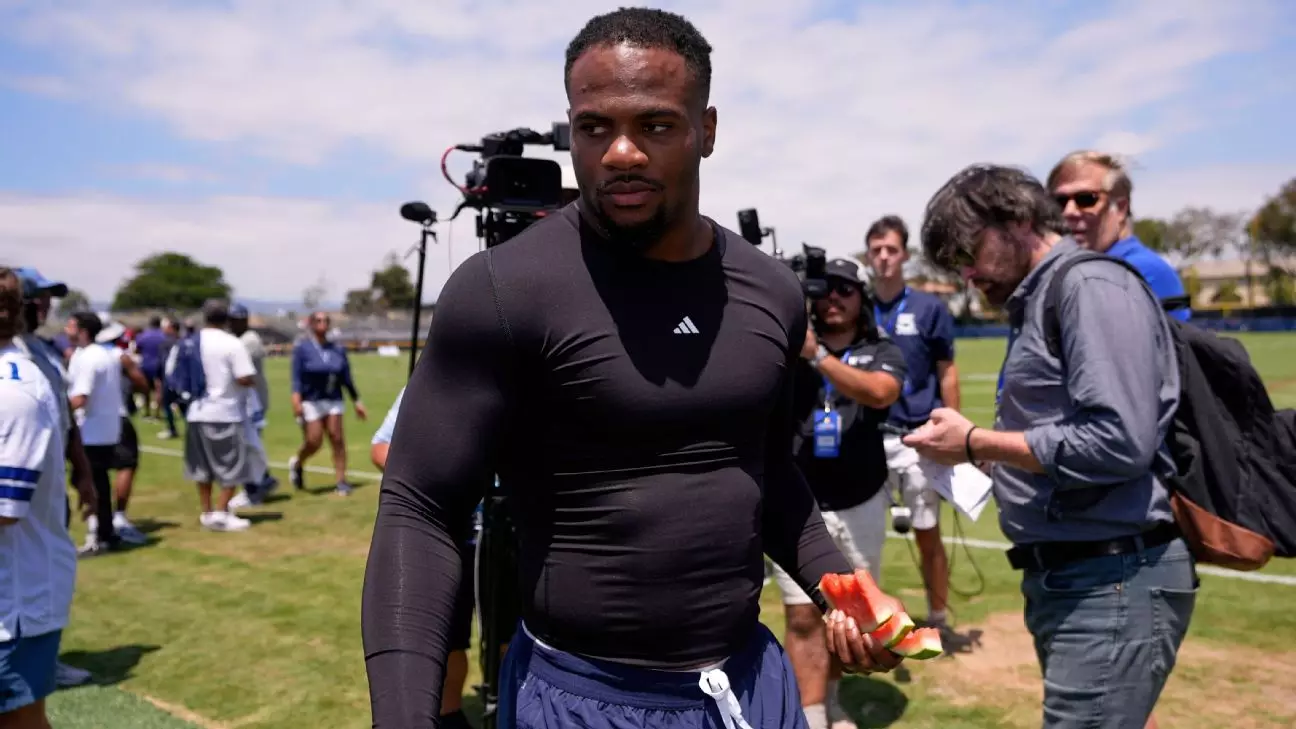In the realm of professional sports, contractual stability is often seen as a cornerstone for optimal performance, yet Micah Parsons’ current situation challenges that notion. Despite the lack of a concrete extension and ongoing negotiations with the Dallas Cowboys, Parson’s dedication remains unwavering. This scenario invites a deeper discussion: Can a player’s potential and motivation shine brightest amid contractual uncertainty? Parsons’ case suggests it might. His absence from practice due to back tightness highlights how external factors—like contract talks—can influence a player’s readiness, but not necessarily his ability to perform. This tension underscores a broader reality in sports: players often thrive despite, rather than because of, the stability surrounding them. The emphasis shifts from contractual security to intrinsic motivation and professionalism. Parsons’ commitment, evidenced by his participation in walkthroughs and meetings, showcases that true athletes retain focus on their craft, even when negotiations stagnate, potentially fueling a narrative that resilience can stem from adversity.
Strategic Flexibility: How Parson’s Limited Practice Might Lead to Tactical Innovation
One of the more compelling aspects of Parsons’ absence from full practice is the ripple effect it could have on the Cowboys’ strategic planning. Coach Brian Schottenheimer’s confidence that Parsons will be ready for the season opener suggests adaptability within the coaching staff. When a key player cannot participate fully in on-field drills, it forces coaches to rethink deployment strategies, which can inadvertently unlock new tactical avenues. Would this limitation inspire the Cowboys to diversify their pass-rushing schemes or lean more heavily on other defensive stalwarts? Such flexibility could prove advantageous in the long run. Moreover, Parsons’ increased involvement in walkthroughs and meetings allows him to absorb schemes cognitively, positioning him as a strategic asset rather than just a physical presence. This scenario exemplifies how adversity breeds innovation—coaches and players must adjust to circumstances, often uncovering opportunities that would remain hidden under typical conditions, potentially elevating the team’s overall defensive strategy.
The Personal Edge: Parson’s Self-Ariced Knowledge as a Catalyst for Peak Performance
Parsons’ reputation as a player who takes exceptional care of his body offers a vital advantage amid uncertain practice conditions. His understanding of his physical limits and proactive self-management could be pivotal in maintaining his explosiveness and agility for the upcoming season. Schottenheimer’s remark that Parsons is “well-aware of his body” reveals an insightful approach that transcends traditional training regimes—self-awareness as a cornerstone of athletic longevity. This personal discipline might shield him from the detriments of limited on-field reps, particularly the risk of soft-tissue injuries. Parson’s ability to mentally simulate game situations during meetings and walkthroughs might even accelerate his readiness for actual game conditions. His self-awareness exemplifies an evolving athlete archetype—one who leverages mental acuity and body literacy to compensate for physical absences, ensuring he remains a game-wrecker before he even steps onto the field. Such attributes are rare and may indeed set him apart as one of the league’s most formidable defenders.
Implications for the Cowboys’ Roster Strategy and Season Outlook
The deferred contract negotiations cast a shadow of tactical uncertainty on the Cowboys’ roster composition. Schottenheimer’s acknowledgment that Parsons’ status influences final roster cuts underscores the interwoven nature of personnel decisions and scouting strategy. If Parsons’ availability remains in question, the team might retain an extra pass rusher, thus impacting the makeup of their defensive front. This scenario exemplifies a broader NFL lesson: success often hinges on strategic flexibility. By keeping a contingency in place, the Cowboys can adapt to fluctuating circumstances—whether its Parsons’ participation or unforeseen injuries—without destabilizing their season plan. Their ability to navigate this delicate balance could significantly determine their defensive potency, especially against high-powered offenses like the Eagles. Ultimately, Parsons’ situation underscores the importance of building a resilient, adaptable roster that can withstand external disruptions and still perform at the highest level.
A Reflection on Resilience and the Power of Preparation
Parsons’ journey encapsulates a crucial narrative in sports: resilience is forged through challenge. His current hurdles—contract uncertainties and limited practice—are not insurmountable obstacles but catalysts for growth. His strategic participation in walkthroughs and meetings demonstrates an unwavering commitment to preparedness, reinforcing the idea that mental and tactical readiness can sometimes surpass physical reps. This mental fortitude, coupled with Schottenheimer’s confidence in Parsons’ ability to adapt, suggests that true capacity is rooted not merely in physical repetitions but also in mental toughness and self-awareness. As the Cowboys prepare for their season opener, Parsons serves as a testament to the idea that perseverance through uncertainty is often the pathway to surpassing expectations and achieving greatness.


Leave a Reply